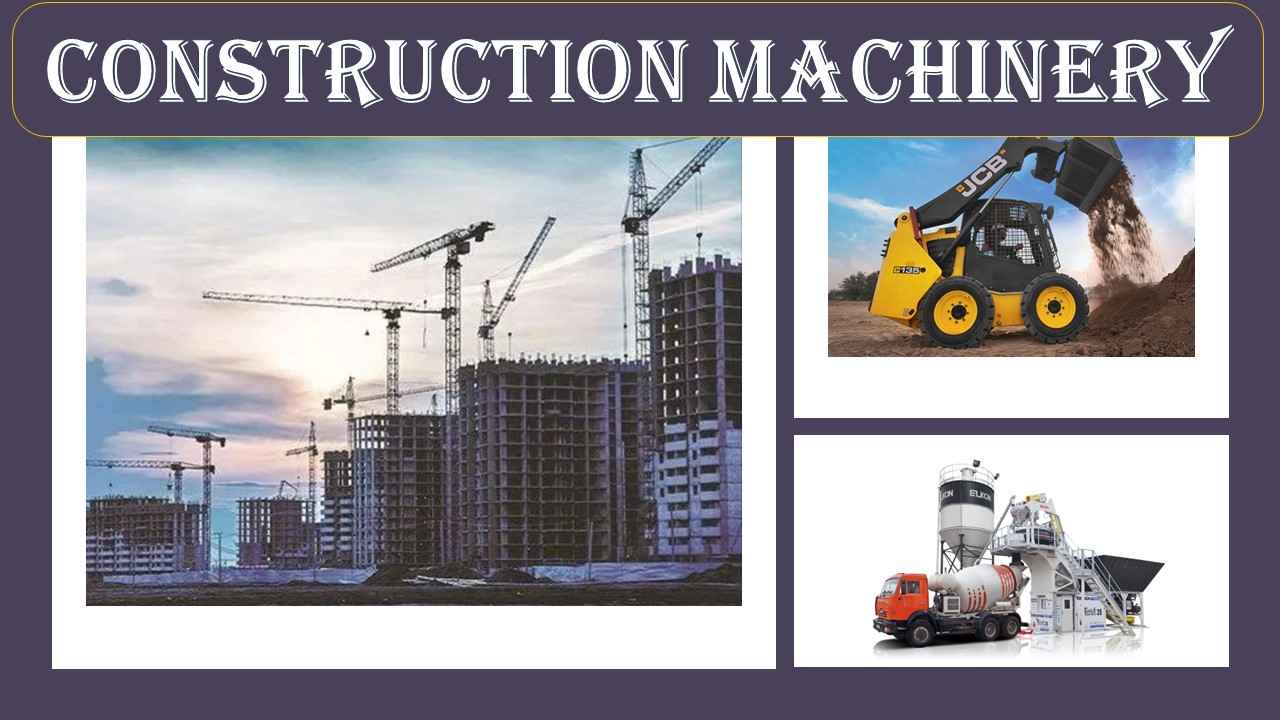Construction Machinery for Mega Building Construction Project
- By
- Pooja |
- September 08, 2023 |
- Civil Engineering, Construction, Building/ Structure Engineering,

Table of Contents
Concrete Mixers and Batching Plants:
Mobile Elevated Work Platforms (MEWPs):
Technological Innovations Driving Efficiency:
GPS and Telematics Integration:
Electric and Hybrid Machinery:
IoT and Predictive Maintenance:
Augmented Reality (AR) and Virtual Reality (VR):
Challenges and Considerations in Utilizing Construction Machinery for Mega Building Projects
Site Conditions and Accessibility:
Equipment Sizing and Compatibility:
Safety Protocols and Training:
Collaboration and Communication:
Cultural and Logistical Considerations:
Construction machinery plays a pivotal role in the successful execution of mega-building construction projects. These colossal endeavors demand precision, speed, and reliability, which are best achieved through the deployment of advanced and specialized equipment.
In this article, we will explore the key types of construction machinery used in mega-building projects, highlighting their functions, benefits, and the technological innovations driving the industry forward.
Excavators:
Excavators are foundational machines in any construction project, including mega-building endeavors. They are utilized for various tasks such as site preparation, digging foundation trenches, and creating underground structures. Hydraulic excavators, in particular, offer the advantage of powerful digging capabilities while maintaining precise control, essential for intricate construction tasks in densely populated urban environments.
Tower Cranes:
As discussed earlier, tower cranes are indispensable in mega-building construction projects. Their ability to lift heavy loads to great heights and precisely place materials makes them essential for assembling structural components, pouring concrete, and installing facade elements. Tower cranes have evolved with features like automation, remote control, and anti-collision systems, contributing to improved safety and efficiency.
Concrete Pumps:
In mega-building projects, the timely and efficient placement of concrete is crucial. Concrete pumps are used to transport and pour concrete to specific locations, even at considerable heights. They minimize manual labor, enhance speed, and ensure uniform concrete distribution, leading to higher quality and more reliable structures.
Bulldozers and Graders:
Bulldozers are employed for earthmoving and leveling tasks, while graders ensure precise grading of surfaces for foundations and roadways. These machines play a critical role in preparing the construction site and creating a stable base for the building's foundation.
Piling Equipment:
For mega-building projects, strong and stable foundations are paramount. Piling equipment, including pile drivers and drilling rigs, is used to create deep foundations by driving or drilling piles into the ground. This machinery is essential for supporting the weight and ensuring the stability of tall and massive structures.
Read More:
Concrete Mixers and Batching Plants:
Consistent and high-quality concrete is vital for the structural integrity of mega buildings. Concrete mixers and batching plants facilitate the precise mixing and batching of concrete ingredients, ensuring uniformity and strength. Modern batching plants are equipped with automation and monitoring systems for efficient and accurate concrete production.
Skid-Steer Loaders:
Skid-steer loaders are versatile machines used for various tasks, such as material handling, excavation, and demolition. Their compact size and maneuverability make them ideal for navigating congested construction sites and performing tasks in tight spaces.
Material Handling Equipment:
Material handling equipment, including conveyor systems, cranes, and forklifts, streamline the movement of materials and components within the construction site. They enhance efficiency, reduce manual labor, and contribute to a smoother workflow.
Demolition Equipment:
In mega-building projects involving the replacement or renovation of existing structures, demolition equipment such as hydraulic breakers, crushers, and excavators equipped with demolition attachments are used to safely and efficiently dismantle old buildings and clear the site for new construction.
Mobile Elevated Work Platforms (MEWPs):
MEWPs, commonly known as aerial lifts or cherry pickers, are used for tasks that require working at heights, such as installation, maintenance, and repairs. They provide a safe and stable platform for workers to access elevated areas of the building.
Technological Innovations Driving Efficiency:
GPS and Telematics Integration:
Modern construction machinery often incorporates GPS and telematics technology to enhance precision, monitoring, and communication. GPS allows for accurate positioning and guidance, while telematics enables remote monitoring of equipment performance, fuel consumption, and maintenance needs.
Electric and Hybrid Machinery:
The construction industry is increasingly embracing electric and hybrid machinery to reduce emissions and environmental impact. Electric-powered equipment, including excavators and loaders, offer quieter operation and lower operating costs while contributing to sustainability efforts.
Advanced Control Systems:
Construction machinery is equipped with advanced control systems that provide operators with real-time data and insights. These systems enhance operator efficiency, safety, and equipment performance by optimizing functions like fuel consumption, load management, and maintenance scheduling.
IoT and Predictive Maintenance:
The Internet of Things (IoT) is transforming construction machinery maintenance. IoT-enabled sensors collect data on equipment health and performance, enabling predictive maintenance strategies that prevent breakdowns and optimize downtime.
Robotics and Automation:
Robotic technologies are finding their way into construction machinery, enabling autonomous or semi-autonomous operation for tasks such as excavation, bricklaying, and concrete pouring. Automation improves accuracy, reduces labor requirements, and enhances safety.
Augmented Reality (AR) and Virtual Reality (VR):
AR and VR technologies are utilized for training operators, simulating construction scenarios, and aiding in equipment maintenance and repairs. These immersive technologies enhance learning and decision-making processes.
In conclusion, mega-building construction projects demand a diverse range of construction machinery to ensure efficiency, precision, and safety.
From excavators and tower cranes to advanced technologies like IoT and automation, these machines and innovations collectively drive the industry forward, shaping the skylines of our cities and the future of construction.
As technology continues to evolve, construction machinery will play an increasingly integral role in meeting the challenges and demands of constructing ever more impressive and complex mega buildings.
Challenges and Considerations in Utilizing Construction Machinery for Mega Building Projects
While construction machinery is pivotal for mega-building projects, its deployment comes with a set of challenges and considerations that project managers and stakeholders must address. The successful integration of these machines requires careful planning, coordination, and a focus on safety and sustainability.
Site Conditions and Accessibility:
Mega-building projects often involve intricate site layouts and constrained spaces, especially in urban areas. Ensuring that construction machinery can navigate these conditions safely and efficiently is essential. Proper site planning, including determining optimal equipment positioning and access routes, helps mitigate challenges related to site conditions and accessibility.
Equipment Sizing and Compatibility:
Selecting the right size and type of equipment is crucial for achieving optimal performance and minimizing operational issues. Oversized machinery may cause congestion and hinder workflow, while undersized equipment may lead to inefficiencies and delays. Compatibility between different types of machinery is also essential to ensure seamless collaboration on-site.
Safety Protocols and Training:
Safety is paramount in construction, and the use of heavy machinery introduces potential risks to both operators and other personnel. Comprehensive training programs are imperative to ensure operators are skilled in equipment operation and safety procedures. Additionally, strict adherence to safety protocols, such as proper signaling, barricading, and protective gear, is essential to prevent accidents and injuries.
Environmental Impact:
Mega-building projects often attract increased scrutiny regarding their environmental impact. Construction machinery, particularly those powered by diesel engines, can contribute to air and noise pollution. The adoption of electric or hybrid machinery, coupled with emission control technologies, helps mitigate the environmental footprint of construction activities.
Maintenance and Downtime:
Construction machinery requires regular maintenance to ensure optimal performance and longevity. Unexpected breakdowns can result in costly downtime and project delays. Implementing a proactive maintenance schedule, supported by predictive maintenance technologies, helps minimize disruptions and maximizes equipment uptime.
Regulatory Compliance:
Construction sites are subject to various regulations and standards that dictate equipment usage, safety measures, and environmental practices. Ensuring compliance with these regulations is essential to avoid legal and financial consequences. Regular audits and inspections help maintain adherence to regulatory requirements.
Budget and Cost Management:
The procurement, operation, and maintenance of construction machinery contribute significantly to project costs. Effective cost management involves careful budgeting for equipment acquisition, fuel, maintenance, and personnel training. Optimizing equipment utilization and minimizing idle time are key strategies to control expenses.
Collaboration and Communication:
Mega-building projects involve multiple stakeholders, including contractors, subcontractors, and equipment suppliers. Clear and effective communication among all parties is essential to coordinate machinery deployment, resolve potential conflicts, and ensure a smooth workflow. Regular project meetings and advanced planning help foster collaboration and mitigate misunderstandings.
Cultural and Logistical Considerations:
For mega-building projects that span diverse geographic regions, cultural and logistical factors can impact machinery deployment. Local regulations, labor practices, and infrastructure availability may vary, necessitating adaptability in equipment selection and operations.
In conclusion, while construction machinery revolutionizes mega-building projects by enhancing efficiency, precision, and safety, it also presents a range of challenges and considerations. Effective project management involves addressing site-specific conditions, ensuring equipment compatibility, prioritizing safety, and embracing sustainable practices.
By leveraging advanced technologies, adhering to regulatory requirements, and fostering collaborative relationships among stakeholders, mega-building projects can harness the full potential of construction machinery while overcoming challenges and achieving successful outcomes. Balancing innovation with careful planning remains key to realizing the architectural marvels that define modern skylines.
Please feel free to like, share and comment.
Admin, gcelab.com Please see our Pillar Post to know why we founded gcelab.com.
Read More:

Pooja
Founder at gcelab.com, Pooja is an Entrepreneur unlocking human potential. Working in the Principles of Lean Start-up, Pooja believes in Transparency and User Happiness the most. Pooja’s background in teaching gives her a sophisticated grasp on even the most tedious aspect of course building. She is passionate about people who believe that good is not enough.


